An emoji 😁 example¶
Let’s make use of what we learned so far and create a simple 1D{1} dataset. To make it interesting, let’s create an emoji dataset.
Start by importing the csdmpy package.
>>> import csdmpy as cp
Create a new dataset with the new() method.
>>> fundata = cp.new(description='An emoji dataset')
Here, fundata is an instance of the CSDM class with a 0D{0} dataset. The data structure of this instance is
>>> print(fundata.data_structure)
{
"csdm": {
"version": "1.0",
"description": "An emoji dataset",
"dimensions": [],
"dependent_variables": []
}
}
Add a labeled dimension to the fundata instance. Here, we’ll make use of python dictionary.
>>> x = dict(type='labeled', labels=['🍈','🍉','🍋','🍌','🥑','🍍'])
The above python dictionary contains two keys. The type key identifies the
dimension as a labeled dimension while the labels key holds an
array of labels. In this example, the labels are emojis. Add this dictionary
as an argument of the add_dimension() method
of the fundata instance.
>>> fundata.add_dimension(x)
>>> print(fundata.data_structure)
{
"csdm": {
"version": "1.0",
"description": "An emoji dataset",
"dimensions": [
{
"type": "labeled",
"labels": [
"🍈",
"🍉",
"🍋",
"🍌",
"🥑",
"🍍"
]
}
],
"dependent_variables": []
}
}
We have successfully added a labeled dimension to the fundata instance.
Next, add a dependent variable. Set up a python dictionary corresponding to the
dependent variable object and add this dictionary as an argument of the
add_dependent_variable() method of the fundata
instance.
>>> y =dict(type='internal', numeric_type='float32', quantity_type='scalar',
... components=[[0.5, 0.25, 1, 2, 1, 0.25]])
>>> fundata.add_dependent_variable(y)
Here, the python dictionary contains type, numeric_type, and components key. The value of the components key holds an array of data values corresponding to the labels from the labeled dimension.
Now, we have a 😂 dataset…
>>> print(fundata.data_structure)
{
"csdm": {
"version": "1.0",
"description": "An emoji dataset",
"dimensions": [
{
"type": "labeled",
"labels": [
"🍈",
"🍉",
"🍋",
"🍌",
"🥑",
"🍍"
]
}
],
"dependent_variables": [
{
"type": "internal",
"numeric_type": "float32",
"quantity_type": "scalar",
"components": [
[
"0.5, 0.25, ..., 1.0, 0.25"
]
]
}
]
}
}
To serialize this file, use the save() method of the
fundata instance as
>>> fundata.dependent_variables[0].encoding = 'base64'
>>> fundata.save('my_file.csdf')
In the above code, the components from the
dependent_variables attribute at index zero, are
encoded as base64 strings before serializing to the my_file.csdf file.
You may also save the components as a binary file, in which case, the file is serialized with a .csdfe file extension.
>>> fundata.dependent_variables[0].encoding = 'raw'
>>> fundata.save('my_file_raw.csdfe')
